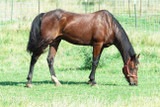What are the signs of Insulin Resistance?
Laminitis – Acute or chronic
Repeat episodes over the years, pasture turnout stopped but still happens, secondary to Cushings disease, more often in ponies, occurs in the middle of the winter when there is no grass around. The horse only gets hay and no grain and still happens.
Overweight – Either by diet, lack of exercise, or genetics
25% of people with Insulin Resistance due to genetics. On no grain or little grain and stays big, exercise & still big. Cresty neck often seen.
Cushings – 2 ways Insulin Resistance is linked with Cushings
A. Many with diagnosed Cushings also have Insulin Resistance but this second condition is not diagnosed, so on Pergolide but still does not do well.
B. Recent study shows Cushings in horses is massively under diagnosed, so if these are missed, then more are missed with both Cushings and Insulin Resistance.
Age
As horses get older, they lose muscle and gain fat. Fat production goes way up in Insulin Resistance because Insulin makes fat and fat produces toxins leading to an increase in Insulin. Also as horses age, Cushings incicdence goes up.
Fatigue – Cannot exercise as well as in the past
They become dull and resist riders.
Certain Breeds
Breeds that were designed for a rugged existence seem to be more susceptible due to today's easier surroundings. These breeds include Quarter Horses, Morgans, Paso Finos, Mustangs, Pony breeds, Tennessee Walkers and Rocky Mountain Horses.
Genetics
The National Institute of Health (NIH) has shown a genetic trait in Insulin Resistance. Often the mare or stallion had Insulin Resistance and now the offspring start to show signs.
History behind the horse
The previous owner warns the new owner that the animal must live on a dirt lot and never be turned out. They are the horses who are fed very little food and stay "fat on air". Sometimes Pergolide helped in the past but is no longer effective.
Fall/Winter foot pain – Even with no grass in sight, the feet get sore
Less exercise, loss of fresh grass, vitamins/magnesium, cold stress, cortisol increase, seasonal ACTH increase, longer fasting periods between food intake all contribute.
Did you know?
Osteoarthritis is worse in Winter – people and horses are stiffer in arthritic joints in cold weather. Less movement so Insulin is up. If more painful, then remember Insulin also goes up with pain.
Abnormally foot sore – After routine trimmings by Farrier
Takes several days after scheduled trimmings to recover soundness. This is an Insulin problem not a bad trim job. The Farrier is the key to a successful program.
Genetic lock – Diet/exercise is not controlling Insulin
If you have tried multiple management techniques but your horse is still foot sore, has repeat laminitis, can't be turned out on grass, and stays big on little food.
These are the horses the HEIRO program can help.
Horses with past laminitis, sore feet or chronic abcessing are going to need daily HEIRO year-round to maintain their health. After they improve, they are not cured of equine insulin resistance, they are controlling it to avoid repeat damaging episodes of laminitis.
Horses with no past laminitis issues that are showing signs of equine insulin resistance and are in areas of snow may use HEIRO seasonally from March 1 – December 1. Many owners do keep their horse on year-round due to how well the horse does. Horses in areas of year-round fresh grass grazing will require year-round HEIRO to help control insulin and keep laminitis away.
The link between insulin resistance (IR) and Chronic Obstructive Pulmonary Disease (COPD) has been studied for years in humans and is now being seen in horses. To read an in depth article printed in Holistic Horse Magazine on a study that points to the links between COPD and IR click here.

